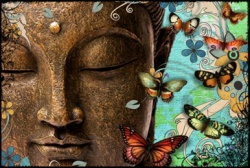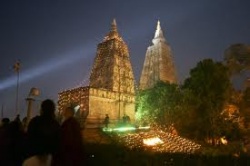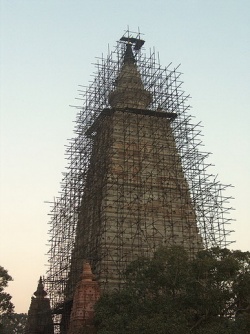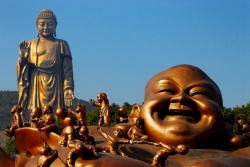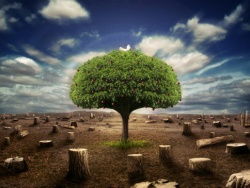The Kayas by Ngakma Nor’dzin Pamo
The exploration of the spheres of being—the kayas—is a method by which we can approach an understanding of nonduality. We can use this method as a means to examine how we exist, and to gain insight into the nature of reality. The kayas (ku sum – sKu gSum) are enumerated as three spheres of being, but this division is purely for the purposes of practice and understanding our existence. The kayas are not in fact separate or divisible. We only speak of the kayas as separate spheres in order to gain insight into their inseparability and the nature of reality. It is not within our capacity to view them as a unity because our view is dualistic – we separate emptiness and form. Therefore we must tease the kayas apart in order to approach an understanding of chö (chos) – as it is.
We look at the kayas separately whilst retaining an awareness of their indivisibility. The logic of this approach can easily be grasped if we use an analogy: if we wanted to explore the nature of the human body, we may look at the separate limbs, organs and tissues in detail in order to understand their function, but this would not prevent us from retaining the knowledge that they are not separately existing entities. We might look at the hand—for example—to study the intricate detail of its bones, ligaments, muscles and blood vessels. We may observe that each individual’s fingerprint is unique, as are the markings and shape of the hand. However we do not expect the hand to exist as an entity in its own right. We do not expect it to be able to wander off and live a separate life – well except perhaps in horror movies. We are able to examine the hand as a separate entity without losing sight of its necessity to exist as part of the whole body and be inseparable from the whole body. It is the same when examining the kayas. We do not examine the kayas individually in order to develop a belief in their separate identity or expect the kayas to arise as separate, independent states. We look at each of the three kayas whilst remembering that this is a means to understand their unification, to understand the fourth all-encompassing sphere of the indivisibility of the kayas.
There are a number of ways to approach and understand the three kayas as can be seen in the table below:
| Dharmakaya | Sambhogakaya | Nirmanakaya | (Sanskrit) |
|---|---|---|---|
| chö-ku (chos sKu) | long-ku (longs sKu) | trül-ku (sPruls sKu) | (Tibetan) |
| sphere of unconditioned potentiality |
sphere of visionary appearance |
sphere of realised manifestation |
|
| Mind | Speech | Body | |
| emptiness | energy | form | |
| Buddha body of suchness or truth |
Buddha body of enjoyment |
Buddha body of emanations |
|
| Sphere of space | Sphere of sensation | Sphere of activity | |
| peaceful | joyous, semi-wrathful | wrathful | |
| Kuntuzangmo (kun to bZang mo) |
Dorje Phagmo (rDo-rje phag-mo) |
Seng-gé Dongma (seng ge gDong dMar) |
(Tibetan) |
| Samantabhadri | Vajradhara | Simha Mukha or Simha Vaktra |
(Sanskrit) |
| Dzogchen | Tantra | Sutra | Example |
| 5 elements | 5 skandas | 5 senses |
The fourth kaya is the unification of the three kayas and the reality of our existence. The three kayas are unified as the fourth kaya (ku-zhi – sKu bZhi): Svambhavikakaya (ngo-wo nyid-kyi ku – ngo bo nyid kyi sKu) or Vajrakaya (dorje ku – rDo rJe sKu).
As the spheres are actually a single sphere, it becomes impossible to talk about one of them without reference to the others. Such apparent contradiction as ‘separate but not separate’ is common in Vajrayana, because we are working to discover the nonduality of that which conventionally appears to be dual – emptiness and form. The base of Vajrayana is emptiness and the path is to discover experientially the nonduality of emptiness and form. Hence Vajrayana conjures paradox: the inseparability of nonduality and our conventional dualistic view. We believe that we are substantial permanent, separate, continuous and defined beings – but through meditation practice and intelligent observation we discover that we are also empty of form and in fact also insubstantial, impermanent, totally connected, discontinuous and lacking in definition. We discover that we exist in the moment as beings of form, but that no solid, permanent, separate, continuous or defined essence moves from moment to moment.
So in the teaching of the kayas we look at emptiness—chö-ku, Dharmakaya—in order to gain understanding of our empty essence; we look at form—trül-ku, Nirmanakaya—in order to examine the nature of our form, our materiality; and we look at the energy—long-ku, Sambhogakaya—the sphere of energetic tension between emptiness and form, where there is the movement of form arising or dissolving.
Chö-ku
‘Chö’ means as it is; ‘ku’ means body, dimension, sphere or field; so chö-ku is the body of suchness, the sphere of unconditioned potentiality, the dimension of as it is. This is the sphere of the nature of Mind and emptiness. This emptiness is not a nihilistic void. It is a potent emptiness, the womb of potentiality – it is the essence of the potential of manifestation, of form arising. It is the emptiness from which all form can arise. This is the part of us that knows – and does not know how it knows and does not question what it knows. It knows without cognition or examination and is beyond intellect. Chö-ku is the sphere that is permanent. It simply is as it is. This potent emptiness cannot be created or destroyed, changed or manipulated; it simply is. Hence the sphere of emptiness displays the form qualities of equilibrium, permanence, separateness, continuity and definition – and lacks the empty qualities of form which are movement and change. The sphere of unconditioned potentiality is primal purity (kadag – ka dag) – that which is all-pervasive and beyond time.
To experience the sphere of emptiness we need to practise emptiness meditation such as shi-nè. Shi-nè enables us to experience ‘Mind-without-thought’ – it allows us to experience empty Mind, when the continuous conceptual babble of ordinary mind subsides. From this space of Mind-without-thought, we can then become aware of thought arising and observe its movement. We can become aware that chö-ku is our natural state; the ground from which everything arises. This state is beyond intellectual understanding and can only be discovered experientially.
In terms of the relationship with the vajra master, chö-ku is the experience of the Lama’s presence display and the open awareness of the potential for transmission in every moment. It is the experience of the presence of one’s teacher at all times in all situations. It is the experience of the Lama as the empty potential of one’s own realisation, and as the empty reflection of one’s beginningless wisdom Mind. It is the recognition of the indivisibility of the internal Lama and the external Lama.
Long-ku
‘Long’ means to arrive at, richness, to receive, communicative, contact. Long-ku is usually translated as ‘enjoyment body’. We cannot enjoy something without connecting with it. That enjoyment is rich, communicative and receptive, so long-ku communicates between emptiness and form, between chö-ku and trül-ku.
Long-ku—Sambhogakaya—is the sphere of intangible visionary appearance that links emptiness and form. It is the display of chö-ku – the energy between the potential of manifestation and manifestation itself. Long-ku is experienced as emotion and sensation, and accessed through practices of voice and vision, whereby we can experience the spatial quality of the realm of form. Anything that is communicative is of this sphere – art, craft, music, dance, horseriding, and all experiences connected with the sense fields. We are aware of manifestation in this sphere, but it is intangible – it cannot be contained or grasped. This is the sphere where the suchness of chö-ku manifests as the energy of the elements. As dualised beings we experience our disconnection between emptiness and form in the energy of the emotions of territorialism or obduracy, aggression, obsession, paranoia and bewilderment. In dualism the energy of long-ku manifests as confused emotion and thought; in nonduality it manifests as liberated energy of the elements.
Whatever the emotional state in which we find ourselves, it will distract the flow of energy in long-ku and channel it into a particular experience of trül-ku. However if we relax and become open to whatever we are experiencing, then we can make contact with the unimpeded flow of energy, and the fundamental nature of this elemental energy. Then we can experience long-ku as enjoyment body (its literal meaning). We can transform our confused emotions into generosity, clarity, compassion, unimpeded accomplishment and wisdom. We can delight in the manifestations of our sense fields and experience them ecstatically.
With regard to the vajra master, long-ku is the experience of the Lama’s personality display. It is the joyful awareness of the potential for transmission in every moment. It is the experience of all emotion and sensation as the colour, flavour, texture, scent and taste of the path of realisation as the Lama's personality. It is the experience of the Lama as an energetic reflection of the energy of rigpa. It is the discovery of appreciation as the energy of transformation, and delight in one’s own personality as an expression of our potential to spontaneously liberate the energy of our neuroses.
Trül-ku
‘Trül’ means manifestation, appearance, emanation, arising into form, so trül-ku is the sphere of form and appearances. From a mundane perspective trül-ku can be understood as the way in which we ordinarily experience ourselves as beings of form in a world of form. However from the perspective of Vajrayana, trül-ku specifically refers to realised manifestation – the experience of form in the moment undivided from the spheres of emptiness and energy. Trül-ku is the sphere of tangible appearance – manifestation that can be touched and experienced by our senses. Just as emptiness essentially displays form qualities of permanence and immutability, form essentially displays the emptiness qualities of movement and change. Form continually arises and dissolves, moves and changes, manifests and subsides. Form is inherently insubstantial because it moves and changes; it is impermanent, continually in relationship with other form, discontinuous and constantly being redefined. Trül-ku’s form qualities cannot be fixed, they are totally, continually in flux. Hence the sphere of realised manifestation displays the qualities of emptiness.
An individual who is described as a Trül-ku is someone who has realised themselves as long-ku and chö-ku and/or has been reborn with a continuity of awareness from their previous life.
Trül-ku is the experience of the Lama’s life circumstances display. It is the inspiring recognition of the ability to dance with everyone and everything everywhere being exactly as it is. It is the willingness to embrace life circumstances whether they are seductive, searing or soporific. It is the awareness of the potential of transmission in every moment and every circumstance of our lives. Devotion spontaneously arises through appreciation of our Lama's capacity to dance with the display of their lives as inseparable from realisation, and this inspires us to courageously engage with the dance of our own lives.
Our dualistic experience of the spheres of energy and form give rise to attraction, aversion and indifference. We are attracted to tangible or intangible form that seems to prove, substantiate or bring pleasure to our existence; we are averse to form that seems to contradict, threaten or mar our existence; and we are indifferent to form that seems irrelevant to our comfort or security. We feed the continual cycle of samsara through these three root misconceptions – striving for experiences that attract us; avoiding experiences to which we are averse; and ignoring everything else. We block our ability to enjoy form in all its wonderfully diverse manifestations. We lose contact with the empty quality of form to be exactly as it is by wishing it to be that which we believe will support the sense of ourselves as substantial, permanent, separate, continuous and defined beings.
The realisation of the nonduality of emptiness and form and the ecstatic energy of this nonduality give rise to the three bodies of the Buddha. From the perspective of Sutra, the emphasis is on emptiness, chö-ku, and the realisation of wisdom. The path is the practice of compassion—bodhicitta—in order to develop wisdom. We realise that wisdom and compassion are nondual as the manifestation of true wisdom is kindness, and the manifestation of true kindness is wisdom. Chö-ku is the fruit of wisdom and long-ku and trül-ku are the fruits of compassion. When compassion is viewed from the perspective of the three kayas, chö-ku makes us open and available; long-ku fills us with the intention to help others; and trül-ku enables us to know how to help others and to give them that help.
In outer Tantra the Lama is chö-ku, the yidam is long-ku and the khandros and pawos are trül-ku. The Lama—the internal Lama and the external Lama—is the source of wisdom. The yidam is the source of power or energy, of visionary experience, and is the method of transformation The khandros and pawos are the source of inspiration. They are the symbols of our emotional confusion, which functions as the fuel that enables us to engage with the method of transformation.
In inner Tantra thiglé (thig-le; bindu in Sanskrit) are chö-ku; lung (rLung; prana in Sanskrit) is long-ku; and tsa (rTsa; nadi in Sanskrit) are trülku. Thiglé, lung and tsa are the components of the subtle body – how we exist at the psycho-physical level. Here the essence of our being is realised and experienced as realised emptiness, realised energy and realised form.
In Dzogchen the three kayas are inseparable and spontaneously experienced as ngo-wo (ngo bo), rang-zhin (rang bZhin) and thug-jé (thugs rJe) – the essence, nature and energy of the inseparability of the three spheres.
Many teachings and practices can be viewed from the perspective of the three kayas. An example would be the practice of Dorje Tsig Dün (rDo rJe tshig bDun): the seven thunderbolt phrases of Padmasambhava. This can be understood at three levels: as an expression of the nature of Mind, which is chö-ku; as an expression of Padmasambhava manifesting as the yidam in visionary form, which is long-ku; and Padmasambhava as an historical figure manifesting the path of realisation, which is trül-ku.

